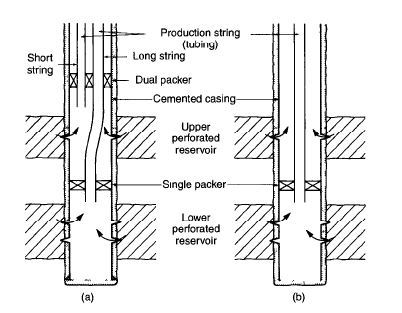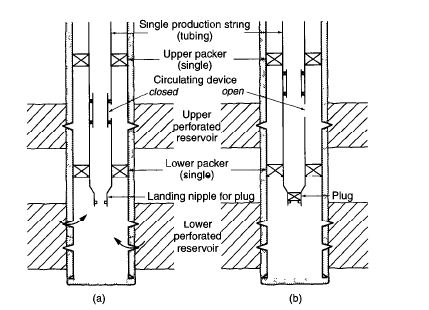In the past, the technique of producing several levels together through the same tubing was used. It required the minimum number of equipment. However, the subsequent reservoir & production problems that were experienced have caused this practice to become much less common.
Must Read: Vodafone Customer Care Number
(a) Parallel tubing string completion and tubing-annulus completion

As observed above, several levels are produced in the same well at the same time but separately, i.e. through different strings of pipe.
Double-zone completions are most common, but there can be three, four, and even more levels produced separately. However, this significantly complicates the equipment that needs to be run into the well and especially makes any workover operations much more complex. There are large number of systems, but let us simply consider;
- Parallel dual string completion with two tubing’s, one for each of the two levels and two packers to isolate the levels from one another and protect the annulus.
- Tubing-annulus completion with one single tubing and one packer, which is located between the two levels that are to be produced, with one level produced through the tubing and the other through the tubing-casing annulus.
Basically this type of completion allows the development of several levels with fewer wells, and is therefore faster. In contrast, maintenance and workover costs are higher. As such it is particularly advantageous offshore (where drilling itself and the space required for a well site are very costly). By taking advantage of a principal level that is being produced, it is also used to develop one or more marginal levels that would otherwise not warrant drilling a well.
However, it should be borne in mind that the ideal completion is the simplest. It will entail the simplest operations in terms of installation, maintenance and workover.
Tubing-annulus completions are very few and far between. Though they have good flow capability (large cross sections are available for fluid flow), this system does not protect the casing, among other drawbacks.
Parallel dual tubing string completions are therefore the typical example of multiple-zone completions. More sophisticated completions require careful study in order to avoid:
- Problems in operation and production due to frequent wireline jobs.
- Problems of safety and operation during workover.
(b) Alternative selective completions:

Here the idea is to produce several levels in the same well separately but one after the other through the same tubing without having to resort to workover. Production alternates in fact and wireline techniques are used to change levels.
This type of completions is especially suited to a situation where one of the two levels is a secondary objective (very rapid depletion, simple observation from time to time, etc.) which would not warrant drilling a well.
Besides packers, this technology also requires extra down-hole equipment such as:
- A circulating device consisting of a sliding sleeve to open or obstruct communication ports between the inside of the tubing and the annulus.
- A landing nipple allowing a plug to be set in the well.
Parallel tubing string and alternative selective completion systems can be combined. For example, two parallel tubing s, each equipped for two levels in an alternative selective manner, can produce four levels separately, provided that only two are produced at the same time.
Well safety:
Here we mean both safety during completion operations as such and also safety later on during production. the main points that need to be taken into consideration are the pressure (down-hole pressure control during operations to prevent blowouts, and equipment’s resistance to pressure). equipment corrosion and erosion, and effluent toxicity.
Reference: Oil & Gas Fields Development Techniques, well completion and services, translated from French by Barbara Brown Balvet and reviewed by Phillippe Beun
– By Suraj Raina (MIT Pune)
